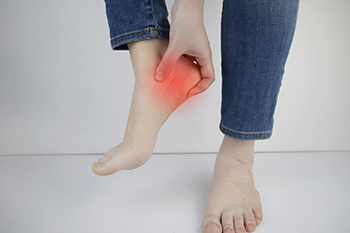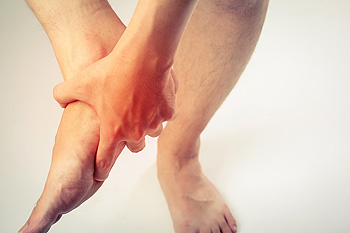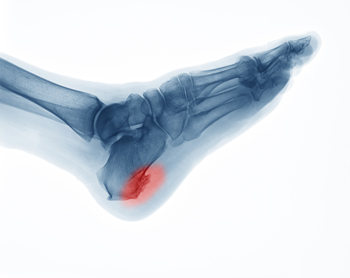Connect With Us
Blog
Items filtered by date: August 2023
Facts About Plantar Fasciitis

Plantar fasciitis is the most commonly reported cause of heel discomfort. This condition targets the plantar fascia, which is a broad ligament that extends from the heel to toes. When it is overused, such as from running for long periods of time, tiny tears can result. This leads to irritation and inflammation and ultimately causes heel pain. The discomfort is more intense in the early morning, but can gradually subside as the day progresses due to the warming and stretching effects on the fascia. Problems with the foot's structure, such as flat feet or high arches, can contribute to plantar fasciitis, but its most common cause is repetitive use. It also can result from prolonged standing or wearing unsupportive footwear. Performing certain stretching exercises, refraining from walking barefoot, wearing appropriate footwear, and periodically resting the feet can help to alleviate the pain. An effective simple morning exercise involves flexing the foot ten times before getting out of bed, or after sitting for an extended period of time. In cases of persistent pain, custom orthotics for cushioning and night splints may be introduced. In more extreme scenarios, corticosteroid injections can offer pain relief. For help in managing the pain of plantar fasciitis, it is suggested that you make an appointment with a podiatrist.
Plantar fasciitis can be very painful and inconvenient. If you are experiencing heel pain or symptoms of plantar fasciitis, contact Ronald Pieroni, DPM from Bolingbrook Foot and Ankle Center. Our doctor can provide the care you need to keep you pain-free and on your feet.
What Is Plantar Fasciitis?
Plantar fasciitis is the inflammation of the thick band of tissue that runs along the bottom of your foot, known as the plantar fascia, and causes mild to severe heel pain.
What Causes Plantar Fasciitis?
- Excessive running
- Non-supportive shoes
- Overpronation
- Repeated stretching and tearing of the plantar fascia
How Can It Be Treated?
- Conservative measures – anti-inflammatories, ice packs, stretching exercises, physical therapy, orthotic devices
- Shockwave therapy – sound waves are sent to the affected area to facilitate healing and are usually used for chronic cases of plantar fasciitis
- Surgery – usually only used as a last resort when all else fails. The plantar fascia can be surgically detached from the heel
While very treatable, plantar fasciitis is definitely not something that should be ignored. Especially in severe cases, speaking to your doctor right away is highly recommended to avoid complications and severe heel pain. Your podiatrist can work with you to provide the appropriate treatment options tailored to your condition.
If you have any questions please feel free to contact our office located in Bolingbrook, IL . We offer the newest diagnostic and treatment technologies for all your foot and ankle needs.
How Footwear Can Help With Plantar Fasciitis Pain

Plantar fasciitis is a common cause of heel pain, with a preponderance of cases in those aged 45 to 65 years old. This condition involves chronic pain on the bottom of the heel where the plantar fascia, the band of tissue that runs along the bottom of the foot from the heel to toes, attaches to the heel. The pain is more severe with the first few steps after sleep or sitting for a prolonged time. It gets worse when standing or walking for long periods and relief is most often found by resting. Risk factors include obesity, a sedentary lifestyle, arch issues, wearing ill-fitted shoes, and standing on the feet for long periods. Understanding the enduring effects of routine footwear on this condition can be helpful, as slight shoe changes might alleviate discomfort and disability. Footwear that works better to prevent plantar fasciitis involves some heel height but not much, hard, well-cushioned soles, and insoles with built-in arch support. If you would like to understand more about how appropriate footwear can calm down plantar fasciitis, it is suggested that you make an appointment with a podiatrist to discuss this issue further.
Many people suffer from bouts of heel pain. For more information, contact Ronald Pieroni, DPM of Bolingbrook Foot and Ankle Center. Our doctor can provide the care you need to keep you pain-free and on your feet.
Causes of Heel Pain
Heel pain is often associated with plantar fasciitis. The plantar fascia is a band of tissues that extends along the bottom of the foot. A rip or tear in this ligament can cause inflammation of the tissue.
Achilles tendonitis is another cause of heel pain. Inflammation of the Achilles tendon will cause pain from fractures and muscle tearing. Lack of flexibility is also another symptom.
Heel spurs are another cause of pain. When the tissues of the plantar fascia undergo a great deal of stress, it can lead to ligament separation from the heel bone, causing heel spurs.
Why Might Heel Pain Occur?
- Wearing ill-fitting shoes
- Wearing non-supportive shoes
- Weight change
- Excessive running
Treatments
Heel pain should be treated as soon as possible for immediate results. Keeping your feet in a stress-free environment will help. If you suffer from Achilles tendonitis or plantar fasciitis, applying ice will reduce the swelling. Stretching before an exercise like running will help the muscles. Using all these tips will help make heel pain a condition of the past.
If you have any questions please contact our office located in Bolingbrook, IL . We offer the newest diagnostic and treatment technologies for all your foot and ankle needs.
Reminder: When Was the Last Time...?
Types and Locations of Ankle Sprains

Ankle sprains are common injuries that can occur during various physical activities. Ankle sprains are categorized into three degrees based on the severity of the ligament damage. A first-degree ankle sprain is mild, with stretched ligaments and minimal fiber damage. A second-degree sprain is more moderate, involving partially torn ligaments. The most severe type is a third-degree sprain, where ligaments are completely torn. Two main types of sprains are inversion and eversion. Inversion sprains occur when the foot twists inward, stretching the outer ligaments and causing pain on the outside of the ankle. Eversion sprains occur when the foot twists outward, stretching the inner ligaments and causing pain on the inside of the ankle. Ankle sprains can also also be classified based on their location. Lateral sprains occur on the outside of the ankle and makeup about 80 percent of all sprains. High, or syndesmotic, ankle sprains are rarer, seen in around 15 percent of ankle sprains. Medial sprains account for about 5 percent of all ankle sprains. Treatment for ankle sprains varies depending on the severity and location. It is suggested that you make an appointment with a podiatrist for a proper diagnosis and personalized treatment plan.
Although ankle sprains are common, they aren’t always minor injuries. If you need your ankle injury looked at, contact Ronald Pieroni, DPM from Bolingbrook Foot and Ankle Center. Our doctor can provide the care you need to keep you pain-free and on your feet.
How Does an Ankle Sprain Occur?
Ankle sprains are the result of a tear in the ligaments within the ankle. These injuries may happen when you make a rapid shifting movement while your foot is planted. A less common way to sprain your ankle is when your ankle rolls inward while your foot turns outward.
What Are the Symptoms?
- Pain at the sight of the tear
- Bruising/Swelling
- Ankle area is tender to touch
- In severe cases, may hear/feel something tear
- Skin discoloration
Preventing a Sprain
- Wearing appropriate shoes for the occasion
- Stretching before exercises and sports
- Knowing your limits
Treatment of a Sprain
In many cases, the RICE method (Rest, Ice, Compression, and Elevate) is used to treat ankle sprains. However, you should see a podiatrist to see which treatment option would work best with your injury. In severe cases, surgery may be required.
It is important to ask your doctor about rehab options after you receive treatment for your injury. Stretching, strength training, and balance exercises may help the ankle heal while also preventing further injury.
If you have any questions, please feel free to contact our office located in Bolingbrook, IL . We offer the newest diagnostic and treatment technologies for all your foot care needs.
Easing Heel Spur Pain

Heel spurs, or osteophytes, are extra bone growths on the heel bone that can cause pain and discomfort. Although only 5% of people with heel spurs experience pain, they can develop from conditions like plantar fasciitis or arthritis, leading to inflammation and pressure on the heel. Exercises can help increase flexibility in the plantar fascia and strengthen foot muscles to reduce inflammation and alleviate pain, though they will not make heel spurs go away. Such exercises include the big toe stretch, calf stretches, golf ball rolls, and more. The big toe stretch involves crossing the affected leg over the opposite leg, gently grabbing the big toe between the thumb and index finger, and slowly pulling the big toe upward until a stretch is felt on the bottom of the foot. Calf stretches are done by standing facing a wall with the hands placed on the wall at shoulder height and stepping the injured foot back about 18 inches. The heel should be flat on the ground and the front knee bent forward. Slowly lean forward until a stretch is felt along the back calf. For the golf ball roll, sit in a chair with a golf ball placed under the bare foot and roll it from the ball of the foot to the heel several times. Other treatments for heel spurs include wearing orthotics, night splints, steroid injections, or in severe cases, surgery. If you have a painful heel spur, it is suggested that you make an appointment with a podiatrist for treatment tailored to your needs.
Heel spurs can be incredibly painful and sometimes may make you unable to participate in physical activities. To get medical care for your heel spurs, contact Ronald Pieroni, DPM from Bolingbrook Foot and Ankle Center. Our doctor will do everything possible to treat your condition.
Heels Spurs
Heel spurs are formed by calcium deposits on the back of the foot where the heel is. This can also be caused by small fragments of bone breaking off one section of the foot, attaching onto the back of the foot. Heel spurs can also be bone growth on the back of the foot and may grow in the direction of the arch of the foot.
Older individuals usually suffer from heel spurs and pain sometimes intensifies with age. One of the main condition's spurs are related to is plantar fasciitis.
Pain
The pain associated with spurs is often because of weight placed on the feet. When someone is walking, their entire weight is concentrated on the feet. Bone spurs then have the tendency to affect other bones and tissues around the foot. As the pain continues, the feet will become tender and sensitive over time.
Treatments
There are many ways to treat heel spurs. If one is suffering from heel spurs in conjunction with pain, there are several methods for healing. Medication, surgery, and herbal care are some options.
If you have any questions feel free to contact our office located in Bolingbrook, IL . We offer the latest in diagnostic and treatment technology to meet your needs.
Running After Enduring a Broken Ankle

Normal activity can resume after an ankle fracture, despite it taking considerable time. A broken ankle can happen from falling, or if something heavy drops on the leg. Immediate symptoms can include bruising, swelling, and it is difficult, if not impossible to walk. Prompt medical attention is often sought, and having an X-ray performed can provide an accurate diagnosis. Once confirmed, a protective boot or cast is worn that can provide stability and mobility while the healing process occurs. Many people who run may be concerned about resuming their running or jogging routine after fracturing their ankle. There are specific stretches that can be done which may help to increase ankle strength and range of motion. When these are frequently performed, the average time for people to start running again may be between three and four months. This can depend on whether surgery was performed, how severe the fracture is, and the amount of effort that is put into doing all that is possible to have a healed ankle. If you have fractured your ankle, it is suggested that you confer with a podiatrist who can help you to heal successfully.
Broken ankles need immediate treatment. If you are seeking treatment, contact Ronald Pieroni, DPM from Bolingbrook Foot and Ankle Center. Our doctor can provide the care you need to keep you pain-free and on your feet.
Broken Ankles
A broken ankle is experienced when a person fractures their tibia or fibula in the lower leg and ankle area. Both of these bones are attached at the bottom of the leg and combine to form what we know to be our ankle.
When a physician is referring to a break of the ankle, he or she is usually referring to a break in the area where the tibia and fibula are joined to create our ankle joint. Ankles are more prone to fractures because the ankle is an area that suffers a lot of pressure and stress. There are some obvious signs when a person experiences a fractured ankle, and the following symptoms may be present.
Symptoms of a Fractured Ankle
- Excessive pain when the area is touched or when any pressure is placed on the ankle
- Swelling around the area
- Bruising of the area
- Area appears to be deformed
If you suspect an ankle fracture, it is recommended to seek treatment as soon as possible. The sooner you have your podiatrist diagnose the fracture, the quicker you’ll be on the way towards recovery.
If you have any questions, please feel free to contact our office located in Bolingbrook, IL . We offer the newest diagnostic and treatment technologies for all your foot care needs.

